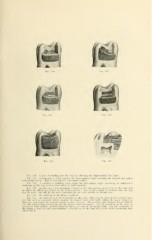Page 565 - My FlipBook
P. 565
Fio. 350. Fifl. 351.
Fig. 352.
Vm. 354.
Fio. 350. A phni of biiiUHng into the step by following the linguo-pulpal line angle.
Fro. 351. Continuing to build against the linguo-pulpal angle covering the lingual and pulpal
walls progressively. This is sometimes a convenient method.
Fig. 352. A method of building across along the disto-pulpal angle, prnduting an independent
anchorage in the step portion from which to build mesially.
Fig. 353. In this case a new beginning is made in the step portion, practically in the same way
in which the filling was begun in the mesial portion. Any of those plans of building into the step
may be used ; one will be the more convenient in one case, another in another case.
Fig. 354. The building of the tilling completed.
Fig. 355. An illustration of the lamination of the gold. This may be divided into sections thus:
(1) The gold is constantly driven against the gingival and axial walls, filling the angle formed by
these two walls until the gingival margin is fvdly covered. This produces the diagonal layers marked.
(2) The gold is then leveled up and the surface made horizontal. (3) The building in the step, no
matter by what method, produces diagonal layers, as seen on the pulpal wall. (4) Tlie remainder of
the filling is done by force iwrpendicular, or nearly so, to the long axis of the tooth, producing hori-
zontal layers.


